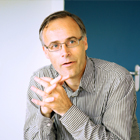"I am driven by curiosity - the thrill that you are going to find
something
that is yet unknown"

An interview with Anton Kunst, Academic Medical Center
Anton Kunst has a long trajectory in research on health inequalities and especially in international comparative projects. He leads the Social Epidemiology research line at the University of Amsterdam and he’s currently coordinating a EU funded project on tackling inequalities in tobacco use (SILNE). In SOPHIE he leads a methodological work package, where he’s mixing his large experience in quantitative analyses with the relatively newer field of realist evaluation.
You are in usual contact with health care profession and public health policymakers. How do you bring the issue of health inequalities to their attention?
We all know that the life expectancy of European countries has increased enormously in the 20th century. And it is still increasing. I point out that this increase in only in part due to medical progress, and even less to better life styles. Social and economic development has been the key to this success. To health care professionals and policy makers, this shows how important social factors are. And they realize that further action on social factors is needed to prevent disease and promote health. This means action to reduce the effects of unemployment, income insecurity, poor housing, unsafe neighborhoods etcetera. Attention to such problems automatically leads to attention to social inequalities, because lower socioeconomic groups are affected most by these problems. To address them is not only a matter of social justice, but also of finding effective ways to improve population health.
How is it possible to understand the so complex pathways between policies, social determinants and health inequalities?
In health care, the essential question is ‘what works’? This also applies to health inequalities. After more than 20 years of descriptions and explanations, a key challenge is to determine whether social policies have been effective in improving population health and in reducing health inequalities. This is also a main challenge to our work in SOPHIE, which we undertake by using quasi-experimental research designs. But our ambitions are more: we do not only want to be able to determine “whether” a policy worked and “how much” effect is achieved, but we also want to learn “how” this policy became effective and “what conditions” were important, to understand how this effect could possibly also be achieved in other situations. For this, we apply the new methodology of ‘realist’ evaluation or review. With this additional step, we aim to generate a much broader evidence to inform those who want to act on social factors.
Could you summarise the main findings of your research on urban renewal in the Netherlands?
We now apply this new approach to a case study on the city of Arnhem, a city formerly called “the Chicago of eastern Netherlands”. Since about 2010, several interventions had been carried out by the municipality to improve safety in deprived neighborhoods. From epidemiological studies, we knew that a safe living environment is important to the health of residents. But were these recent interventions really effective in improving safety among residents? and how? We observed that Arnhem approach was effective in addressing the pressing issue of multi-problem households. Our research supported the “program theory” of the local policy makers, according to which the multi-problem households should be offered social care but also threatened with sanctions, and that local agencies could deliver this ‘care and sanction’ package if they work together under a model of centralized cooperation. Moreover, in one deprived district in the centre, this new approach lead to an improvement in perceived levels of safety. However, no such positive effects were observed in other deprived neighborhoods, and we are yet trying to understand what happened there.
What advice would you give to a young researcher interested in the field?
I started doing research in 1983, when I visited Mexico City to study inequalities in infant mortality. Even since, I have liked doing research. To young researchers, I would like to tell why I am still enthusiastic about every new study. I am driven by curiosity - the thrill that you are going to find something that is yet unknown. This curiosity is at the heart of every study that I undertake. To ensure this, I only start a study after I got a clear research question that really interests me. This must be a question for which I don’t know the answer, and for which any answer is ‘good’. To me, there are no ‘negative’ answers; any answer is of interest. That’s why I want to publish a paper on every study that I start – now more than 250. If your initial research question interests other people too, they will find your paper interesting as well. And if you really are anxious to know the true answer, you won’t take the easy way of superficial data analyses, analyses geared to getting ‘positive’ or ‘significant’ results, or one-sided interpretations of your findings.
